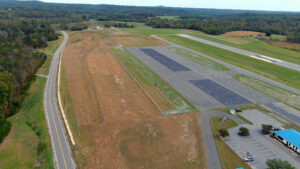 WK Dickson has received an Engineering Excellence Merit Award from the American Council of Engineering Companies of Virginia for our work on the Apron Expansion and Road Relocation Project at the Blue Ridge Regional Airport (MTV) in Martinsville, VA. This project represents an incredible journey spanning nearly two decades, encompassing careful planning, strategic land acquisition, environmental considerations, innovative design, seamless construction, and skilled construction management. The endeavor expanded the main apron at MTV by 27,000 sq yards and relocated Airport Drive to cater to larger corporate aircraft, setting the stage for enhanced aviation capabilities at the airport, including the upcoming runway extension.
WK Dickson has received an Engineering Excellence Merit Award from the American Council of Engineering Companies of Virginia for our work on the Apron Expansion and Road Relocation Project at the Blue Ridge Regional Airport (MTV) in Martinsville, VA. This project represents an incredible journey spanning nearly two decades, encompassing careful planning, strategic land acquisition, environmental considerations, innovative design, seamless construction, and skilled construction management. The endeavor expanded the main apron at MTV by 27,000 sq yards and relocated Airport Drive to cater to larger corporate aircraft, setting the stage for enhanced aviation capabilities at the airport, including the upcoming runway extension.
If you know Martinsville, VA, you know it’s home of the paperclip-shaped oval Martinsville Speedway – the shortest oval in NASCAR. Another popular destination in the Martinsville area is Primland, a luxury resort renowned for its stunning natural surroundings, world-class amenities, and wide range of outdoor activities. The Blue Ridge Regional Airport supports these facilities and the local community but was in great need of expansion. Before the completion of this project, visiting aircraft were routinely constrained due to a lack of available apron space for maneuvering and staging. Often, aircraft would divert to other airports due to congestion at MTV. Getting this project off the ground was complicated and required navigating several roadblocks.
The Blue Ridge Airport Authority (the authority) underwent a nearly 20-year process to acquire the necessary land and relocate Airport Road to provide an additional 27,000 SY of apron space. Environmental permitting, design, publicly bid construction documents, and coordination with VDOT for approval were all part of the process for completing the project.
In 2013, the FAA told authority leaders that the agency was not funding any pavement expansion projects at general aviation airports because AIP entitlement monies and discretionary funds were limited. VDOT’s input was that they weren’t in the business of relocating a perfectly good road. At the time, the project was at a standstill.
Undeterred, the authority continued to position themselves for the expansion. In 2018, our team (previously Eden & Associates and now WK Dickson) updated the airport’s master plan. We presented the FAA with its results along with written requests from over 20 corporate aircraft saying that they don’t fly into MTV if there’s a chance of rain or hot weather as the airport’s 5,000-foot runway couldn’t accommodate the larger aircraft. The authority coordinated with a local non-profit organization, the Harvest Foundation, and gained financial support for the expansion of the runway to 6,000 feet. Although not directly involved in this project, the local support showcased to the various funding agencies underscored the authority’s unwavering dedication to implementing significant enhancements in their facilities.
Shortly after that, our team convinced the FAA to acknowledge the need to accommodate larger aircraft and proceed with improvements to the runway and corporate apron areas. Through several meetings with VDOT officials, the project gained support and momentum, culminating in the approval for the relocation of approximately one mile of Airport Road. The relocation provided the space necessary for the associated apron expansion. The airport is continuing its push forward and has begun Phase 1 of the runway extension to a total length of 6,000 feet. Phase 1 also requires relocation of Airport Road and is utilizing funds from a VDOT airport access road program – the first grant from this program in 12 years.
The airport director kept meticulous records for incoming flights as well as flights diverted to other larger airports for various reasons throughout the build-up to construction. That documentation was the catalyst needed to demonstrate the project’s necessity and gain support from the FAA and DOAV for expanding the apron and extending the runway. The justification for the two projects was intertwined. Corporations have been flying larger aircraft in recent years (like the Gulfstream G650 pictured above), and these aircraft require greater apron space for maneuvering and staging and longer runway lengths for operations, particularly during inclement weather.
What makes the accomplishment of the apron expansion remarkable was the persistence and dedicated effort of the entire team and the support from key partners, including the FAA and the Virginia Department of Aviation, who provided essential grant funding throughout the project’s various phases. Coordination with VDOT was also paramount, especially in relocating the state-maintained Airport Road. Within ten years, the apron expansion project went from a non-starter standstill to completed construction. The dedicated effort also resulted in the ongoing runway extension to 6,000 feet. Neither project was considered viable just ten years ago.
“The apron expansion will allow the airport to accommodate larger airplanes and a higher volume of traffic. That’s really going to make our window to the community much bigger and much more capable,” said Jason Davis, the airport’s managing director.
This project is just the beginning of significant improvements to the airport. In preparation for the runway extension to 6,000 feet in total length, the apron expansion geometry will accommodate larger corporate aircraft demands, particularly during peak travel season and the two race weekends for NASCAR events at Martinsville Speedway.
A special thank you to the dedicated staff of the following organizations for their efforts in making this project possible.
Blue Ridge Airport Authority
Virginia Department of Aviation
Federal Aviation Administration – Washington Airports District Office
Henry & Patrick Counties
W-L Construction & Paving
Austin Electrical Construction Inc.
ECS Mid Atlantic, LLC
